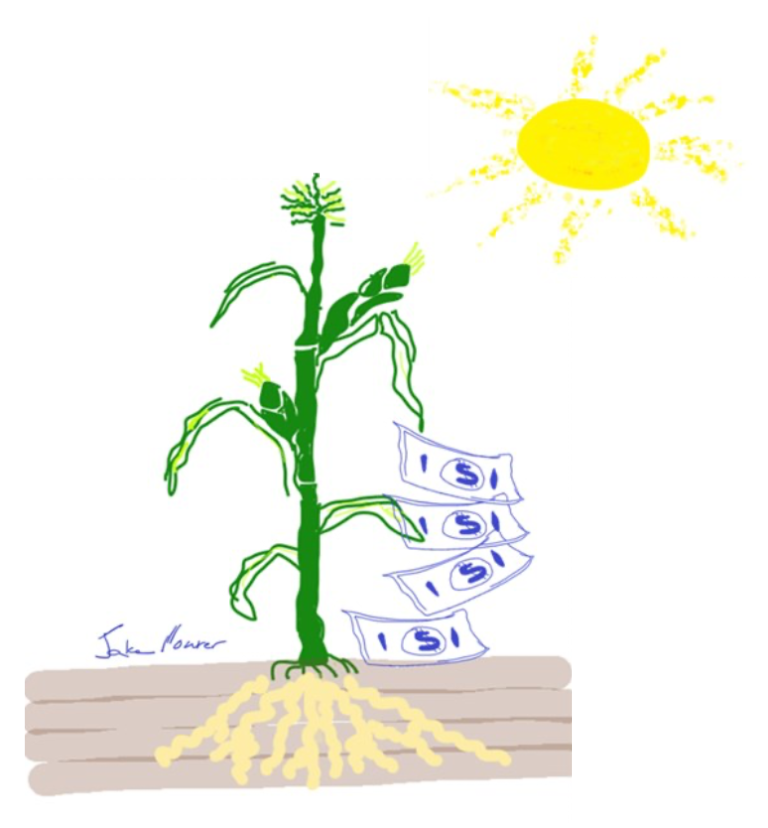Let’s say that the fundamental currency for exchange in the universe is energy. Even paper and digital money we handle each day is a proxy exchanged for and representing the energy we spent on someone else’s behalf.
The plant Kingdom (with extremely rare exception) is very special in that its members use the energy from sunlight directly in order to grow. This process is called photosynthesis, and people piggy-back on plants to gather the energy we need. We call it harvesting. The energy from the sun is stored in the grains and vegetables we consume. In order to produce those grains and vegetables, plants must invest a significant amount of their energy into the development of their root systems.
Why? Well as it turns out, soils are in fact not quite the hospitable environment for plants that we generally think they are. Soil does provide nearly all the things a plant could need, including:
- Physical anchoring to the Earth’s surface preventing massive loss of plant life to outer space,
- many (but not all) nutrients required,
- water storage, and
- a habitat for beneficial organisms to inter- act with.
However, the soil does not do all of this as freely as we might think. Plants are not passive actors in the soil environment, humming along to themselves idle while nutrients and water jump into their roots. Rather, it takes a substantial amount of effort by the plants to wrest and wrangle away the basics needed to eke out a living from the soil. As a matter of survival, then, they must invest some of the energy gained from sunlight in this process.

Energy (derived from the sun) is the only real currency plants trade in. They transfer energy and other products of photosynthesis to their roots, which stimulates important interactions with the most diverse ecosystem on the planet – the soil micro-biome. Wherever roots grow, natural and agricultural soils benefit profoundly from these interactions. They provide enhanced nutrient and water access, organic matter, greater resilience to stress for above ground plants, and many other things.
Soil can be thought of as an inanimate physical matrix of solid mineral particles with many small spaces in between. Plants’ roots must exert great physical energy to move soil particles aside to create space for their own existence. This costs photosynthetic energy (an ex- change of currency). There is a limit to the force which roots may exert. Therefore, compacted soils prevent exploration by roots through the soil volume simply due to excessive requirements in penetrative force. Tilth, an admittedly antiquated but still relevant term, captured in its description a set of soil conditions wherein root proliferation was favored. Today, we still consider buildup of organic matter and absence of compaction to favor root growth and the associated benefits of a robust soil microbial ecosystem.
Soil nutrients are often bound in chemical forms that plants simply cannot access easily. Any nutrient must be dissolved in water prior to plant uptake. So plants have evolved different ways of taking up different nutrients. Some may freely pass from soil solution into the root while others require some expense of energy to ‘absorb’. However, soil minerals interact chemically with nutrients in ways that limit their solubility. Soil organic matter forms insoluble complexes with nutrients like nitrogen, phosphorus, sulfur, and micronutrients. Plants must therefore spend photo-synthetic energy producing and releasing (exuding) a complex cocktail of their own chemicals through the root system to improve the chances of dissolving nutrients. Again, roots are earning their in-vestment by working hard to get what the plant needs.
Soil acts a little like a sponge, exerting a pressure that holds water in its matrix of solids and spaces. Plant roots must exert an opposing and greater pressure on that water in order to absorb it. The less water there is, the more energy it takes.
Plants also like their tiny friends and helpers in the soil. Plants perform better when they interact with naturally- occurring soil micro-organisms that include bacteria, fungi, nematodes, arthropods, and insects. Many of these organ- isms feed on soil organic matter, so soils with very little organic matter also tend to support low levels of beneficial organ-isms. Plants like a dirty environment, teeming with life. The reasons are more complex, but the result is simple. More roots grow in the soil when there is organic matter present.
Furthermore, beneficial organisms are also known to help offset the negative effects of other tiny organisms that may eat plant roots or infect them, causing diseases. They may compete with non- beneficial organisms for food and other resources, reducing numbers. And in many cases, they can actively assist in plant defense against disease and root feeding.
Plant roots complete a cycle in the soil. The deeper they go, the more benefits they provide to soil fertility and stable carbon storage in soils. While alive and active, roots redistribute carbon and nutrients throughout the soil profile. When roots die, they decay, leaving behind more organic matter – providing residual bene-fits to the next season’s plants.
Roots are made of different stuff than plant tops, or shoots. They contain a lot more lignin than shoots, which lasts longer in the soil. This provides more stable and longer lasting soil organic carbon.
Managed lands under agricultural production represent the areas with the most potential for improving soil fertility and increasing carbon storage. These benefits will be realized only by paying more attention to roots. Proper management can encourage our crop roots to proliferate through the soil in a way that provides an economic return in terms of both energy and money back to the farmer. This can help us better realize the sometimes apparently conflicting
(Though in reality often aligned) goals of providing global food security through long term and sustainable soil productivity, and shifting the excessive carbon floating around the Earth’s atmosphere back into its soils.



